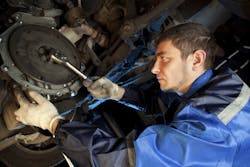There is such an extensive assortment and variety of non-powered hand tools because each is designed for specific functions. It is important, therefore, to select the appropriate hand tool for the task and to use it properly.
Not doing so can result in lost productivity from slower work and more errors. Using the wrong tool also increases the risk associated with its use.
A best practice is to select well-designed, high-quality hand tools. These will make the technician’s job safer and easier, improve the quality of the work being done and help extend the life of the tool.
It is imperative that hand tools be kept in optimum condition. In addition to compromising safety, tools that are in poor or worn condition also increase the effort needed to use them.
Damaged tools should never be used. They should be repaired or replaced immediately.
UNSAFE PRACTICES
While it is generally assumed that technicians know how to use hand tools, accidents from using them are a significant cause of workplace injuries. Many of today’s on-the-job injuries result from the improper use of hand tools, unsafe practices and/or the use of tools that are poorly designed or of inferior quality.
Estimates are that hand tool mishaps are responsible for about one out of 12 compensable workplace injuries. These accidents cause downtime and that impacts the job and shop productivity.
Plus, depending on the injury, a technician may not be able to do his job.
As with other tools, when using hand tools, technicians should always wear the PPE required for the job.
CHECKLIST
Some general key purchasing considerations:
- Tool design, including style, size, weight, etc. Tool shape directly impacts hand tool performance.
- Ergonomics. How well does the tool fit the hand? Can it be used in a comfortable work position without causing awkward postures, harmful contact pressures or other safety and health risks? Do the balance and the weight feel right? How easy is it to operate?
- Quality.
- Warranty/guaranty.
- Product support.
- Brand reputation.
- Budget range/price.
About the Author

